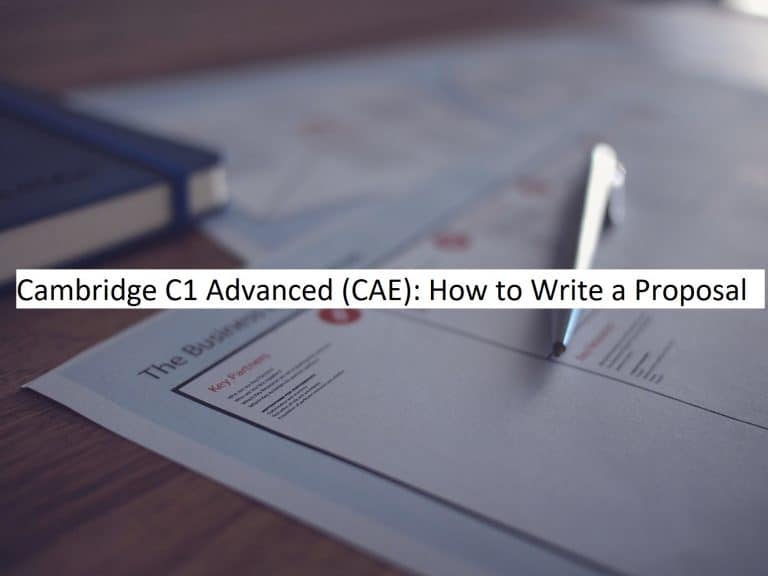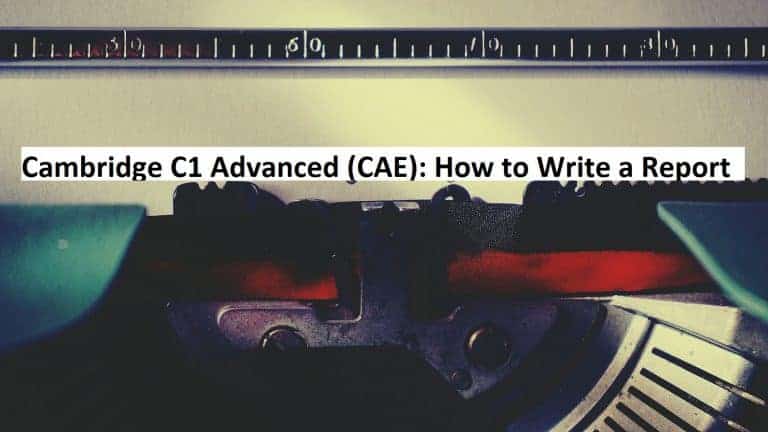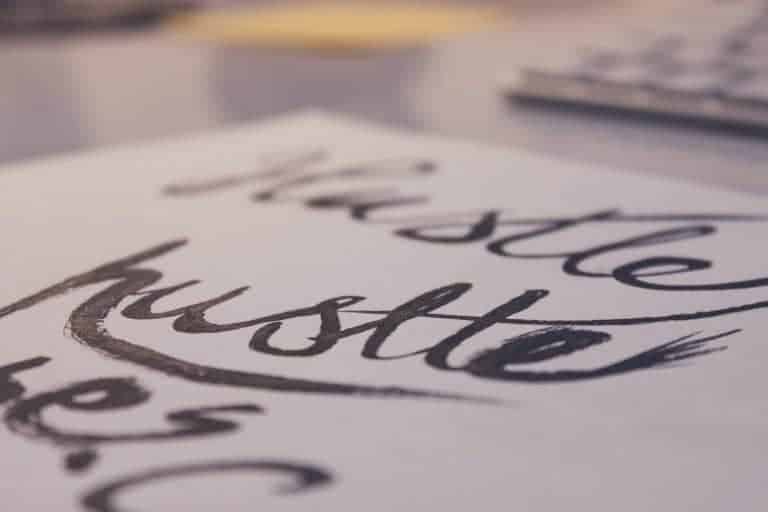Get Your Free C1 Advanced Writing Cheat Sheet Now!
Just leave your name and email address below.
Thank you!
Please check your email inbox and spam folder for your free PDF.
Reading and Use of English
Where should I start? Should I tell you about the screams of protest, the tears and the agony I have to deal with when it is time to practise Reading and Use of English in my C1 Advanced preparation classes? Should I mention the cold sweat on my students’ foreheads when we do a mock exam in class? Or should I tell you that I like drama and I’m pretty good at exaggerating?
I guess all of the above is true in one way or another. Reading and Use of English is definitely not the most beloved part of C1 Advanced, but I also know from my own experience, having taught hundreds of students in the dark arts of mastering Cambridge exams, that it is not rocket science.
You need to understand that there is no reason to be afraid. Everything’s a matter of knowledge and preparation. The second part is your responsibility, but the first one…you’ve come to the right place.
Reading and Use of English is two exam papers in one with Reading being one part and Use of English the other, which means that you’re taking two tests in one. This can have several implications for how to approach this part of C1 Advanced, but we are going to discuss everything you need to know later on.
You need to know what each task looks like, what is expected of you in each one of them as well as how to manage your time and how to prepare in the most effective and efficient way.
If you are intrigued, keep reading.
Timing is key
Time management might be the most crucial aspect of not just Reading and Use of English specifically, but probably the whole C1 Advanced exam in general, so it is important to be aware of the timings and restrictions in each paper.
In Reading and Use of English, you have to complete eight different parts and transfer your answers onto a separate answer sheet that you get at the beginning of the test in only 90 minutes. If we assume that it takes the average person around five minutes to complete the answer sheet, we are left with 85 minutes for eight tasks or roughly 10 1/2 minutes per task.
Without good preparation or the right strategy you can get yourself into time trouble really quickly. If you don’t want to fall into this trap, take the time (no pun intended) to read this article and you will see what you need to be careful with, how to can strategise effectively and how you can prepare for Reading and Use of English in order to save time and become great.
The different parts of Reading and Use of English
Cambridge C1 Advanced has five parts. In the exam, you do these five parts in four papers:
- Reading and Use of English
- Writing
- Listening
- Speaking
Reading and Use of English usually comes first on the day you take the exam. For many candidates, this is the hardest section as there are eight different parts which include quite a lot of text to read (3,000-3,500 words in total) and a pretty tight time limit of only 90 minutes. As you do two papers in one, Reading AND Use of English, it accounts for 40% of your overall mark in C1 Advanced.
First of all, let’s see what the different parts in Reading and Use of English look like.
Part 1 – multiple choice cloze (a text with gaps)
You read a short text with eight gaps. For each gap, there are four possible words to choose from (A-D). This part tests your vocabulary skills, or more specifically your knowledge of idioms, collocations, fixed phrases, etc.
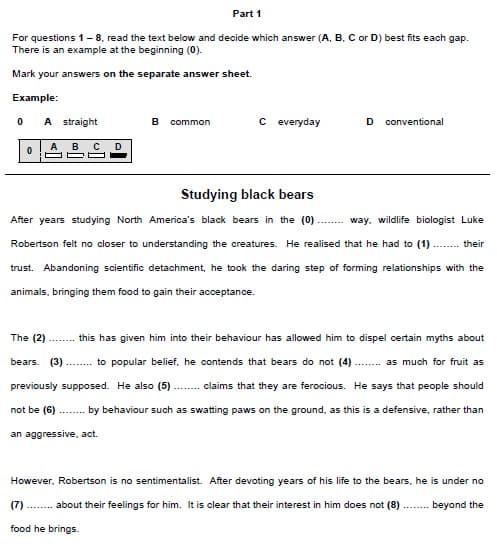
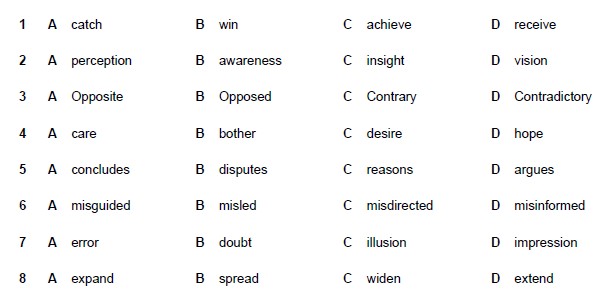
Part 2 – Open cloze
In Part 2, you read another short text with eight gaps, but this time, there are no options to choose from. Instead, you need to analyse the gaps and decide by yourself what is missing in each gap. The focus shifts from vocabulary, as in Part 1, towards grammar and you need to demonstrate your knowledge of the control of different grammatical structures.
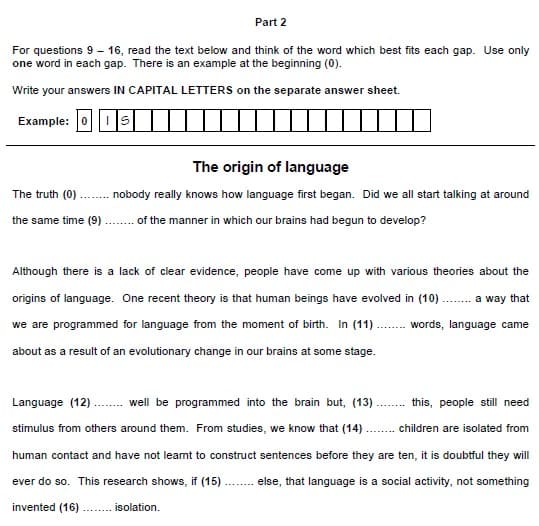
Part 3 – Word formation
Another short text with eight gaps. Next to each gap, you find a word which you have to transform in order to make it fit the grammatical context. Knowing your prefixes and suffixes is key to success here.
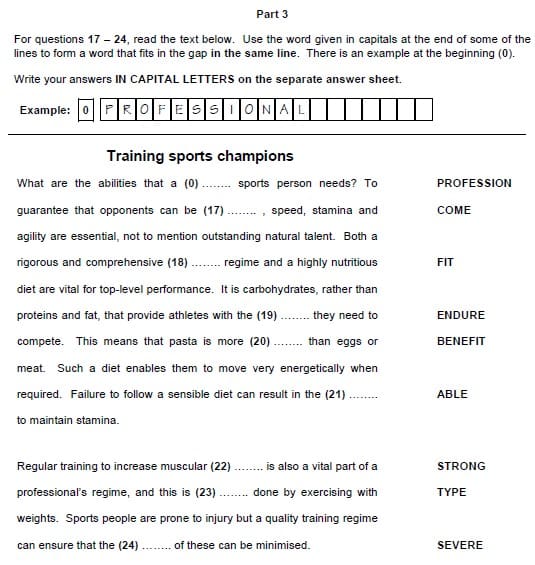
Part 4 – Key word transformation
Part 4 is one of the trickiest ones in Reading and Use of English as it covers such a wide range of grammar that many candidates struggle, especially under time pressure.
You are presented with six pairs of sentences. The first sentence of each pair is the lead-in sentence while the second one contains a gap. You need to fill in the gap with 3-6 words, but there is one ‘key word’ given to you that you have to include unchanged.
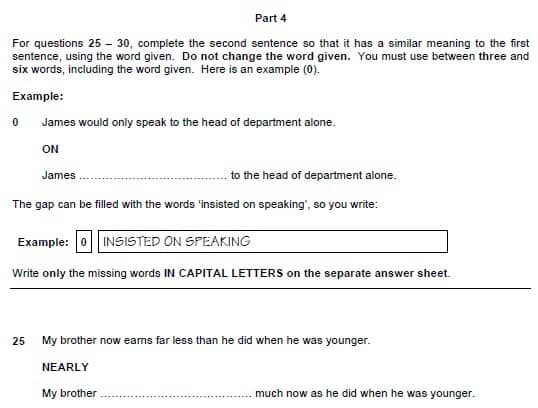
Part 5 – Multiple choice
In this first true reading task, you have to analyse a text and answer six questions, each of which comes with four possible answers (A-D). This task tests a range of reading skills and different levels of understanding, for example, gist, attitude and opinion, tone, detail, purpose, etc.
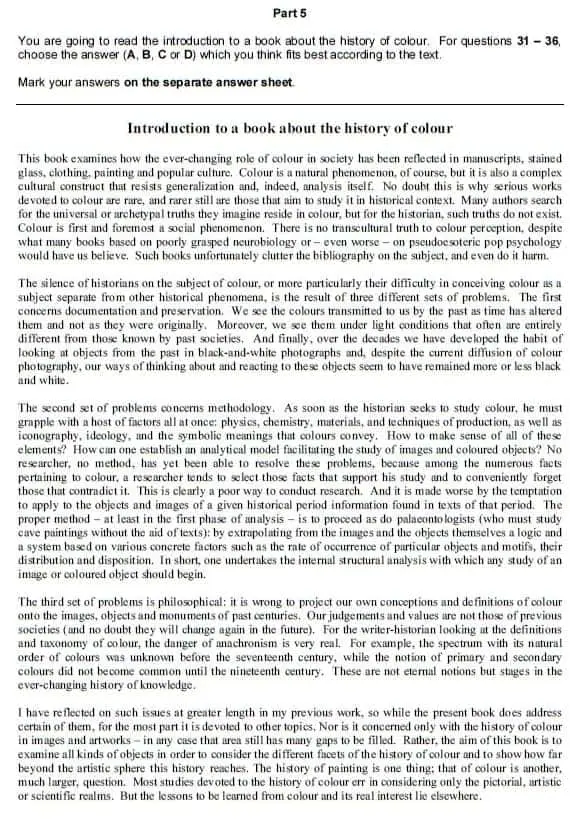

Part 6 – Cross-text multiple matching
In Part 6, you read four shorter texts and answer four questions which are designed so you have to read across the different texts. You are tested on your understanding of opinions and attitudes and your ability to compare and contrast these opinions.
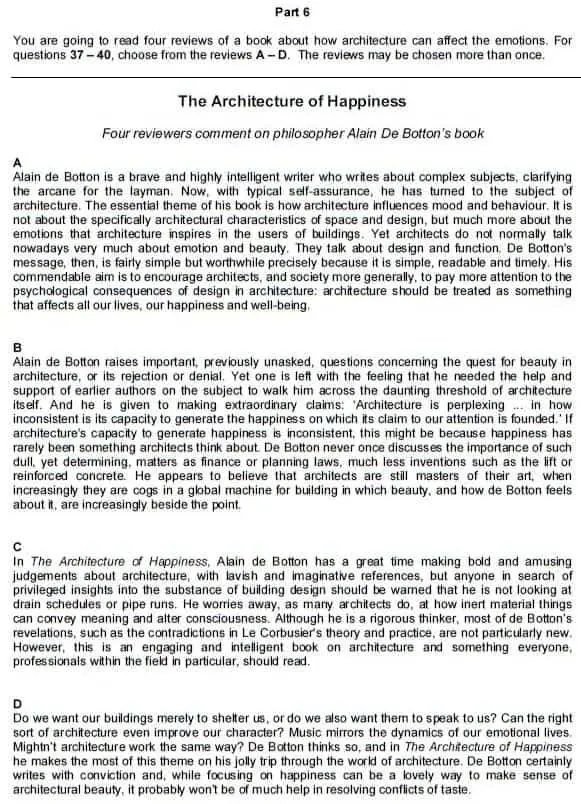
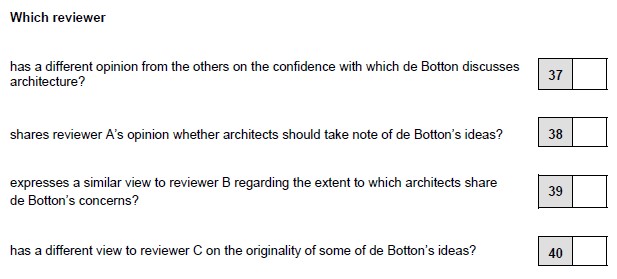
Part 7 – Gapped text
Another longer text from which six whole paragraphs have been removed. You have to choose the matching paragraphs from seven possible options, which means that one of the paragraphs doesn’t have to be used.
This part tests your understanding of coherence and cohesion as well as text structure and global meaning.
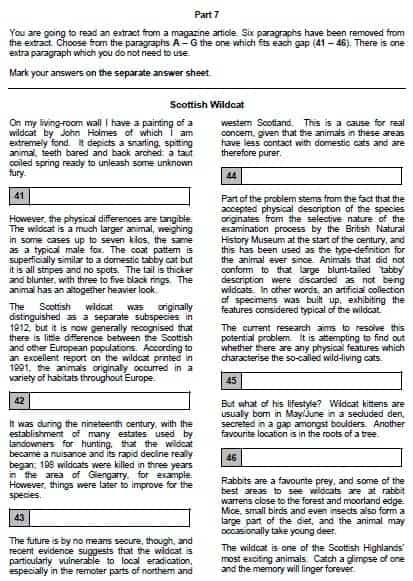
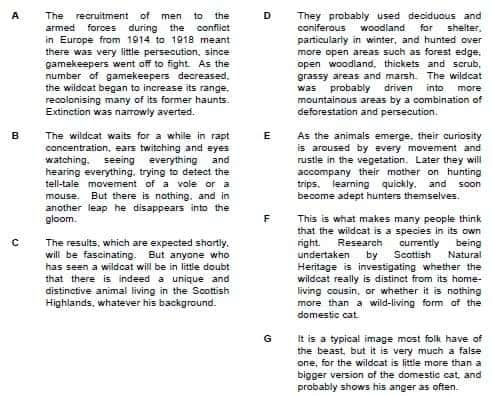
Part 8 – Multiple matching
In the last part of Reading and Use of English, you get to read one longer text or several shorter texts plus ten multiple-matching questions. Candidates are required to match each question to one of the parts or short texts.
You have to show your ability to identify specific information, detail as well as opinion and attitude.
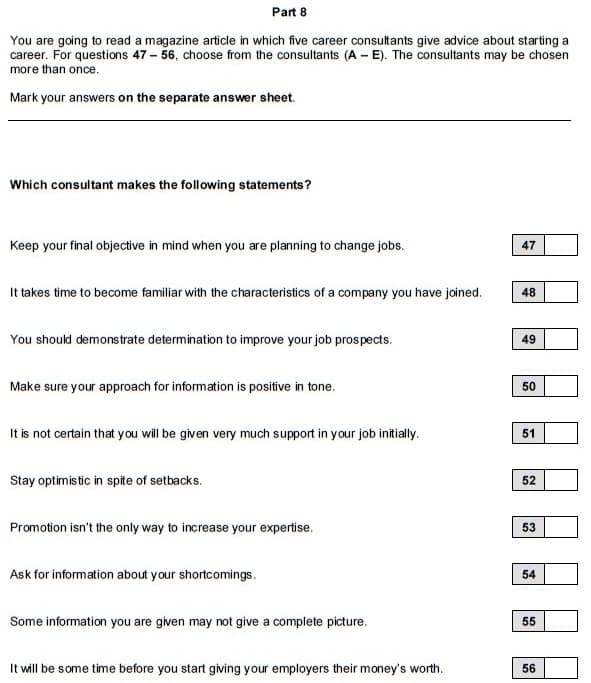
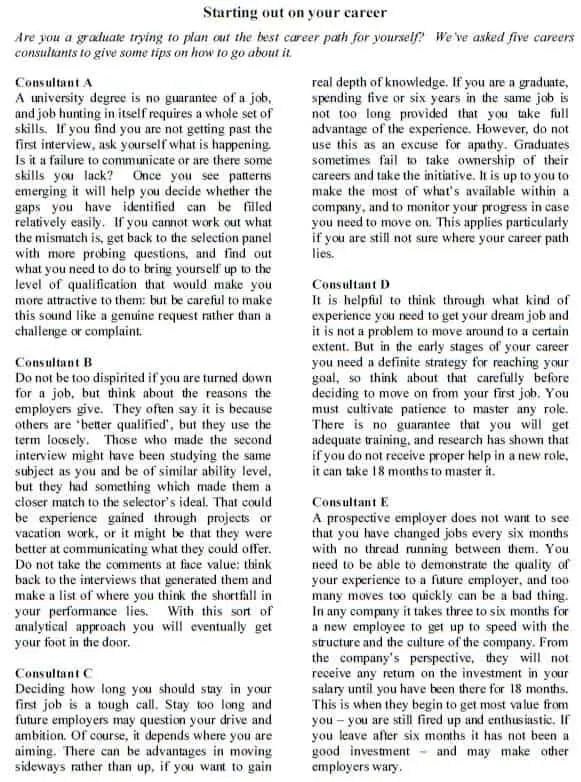
If you want to find out more about the different parts of Reading and Use of English, just follow the links in the slideshow below.
Which part should you start with?
While most candidates don’t worry too much about this question, it can be worthwhile thinking about the order in which you want to tackle the eight different tasks in the exam.
All of this should be part of your preparation, but I’m going to show you a few possible strategies or philosophies when it comes to task choice. This way, you might be able to make an informed decision that can save you time and a lot of headaches.
Don’t worry about it at all
This is the strategy (or should I say ‘non-strategy’?) that most candidates follow. They don’t give this whole process too much though and simply run through the exam from the beginning to the end.
Let me assure you that there are more efficient ways to do this, but if you feel confident in your abilities and time management, go for it. If you want to know more, keep reading.
Use of English before Reading
Here we have one of the most popular plans that is also recommended by quite a few teachers I know. The strategy is based on the idea that we are looking at to tests in one – Reading AND Use of English. Most candidates struggle with the latter and feel more confident about the former. Therefore, they try to do the harder part at the start when they are still mentally fresh.
The sequence looks like this: 2, 3, 4, 1, 5, 6, 7, 8
Parts 2, 3 and 4 come first as they make up the Use of English section followed by the rest (Reading). It is a good way of tackling your weakness first and then cruise through the rest without having to worry.
Hunt for marks
Another popular way of looking at the exam is to follow the tasks that have the highest potential for good marks.
As many candidates don’t realize, there are some tasks that earn you 2 marks for a correct answer (4, 5, 6 and 7) while other answers are worth just 1 mark (1, 2, 3 and 8). It can be beneficial to try and do these higher-mark tasks first and leave the rest for later when you start to get tired.
This might be the sequence to follow: 4, 5, 6, 7, 1, 2, 3, 8
We maximise your mark-earning potential by doing the more valuable tasks first and, from there, move on to the tasks where you have to work harder for higher marks.
Summary
Choosing the right sequence for Reading and Use of English can be important if you know that you struggle with certain tasks or if you might get into time trouble towards the end of the test. Take some time during your preparation and think about a sequence that works best for you and your needs. You can focus on the task type, the potential number of marks or anything else that you think could help you maximise your final score.
How can you prepare for Reading and Use of English?
When it comes to preparing for C1 Advanced, many candidates get into exam preparation exercises, develop strategies and look at all the tips and tricks they can find until they know the exam inside out.
First of all, there is nothing wrong with that. I would even say that it might be the most important aspect of your preparation efforts. However, way too often I meet students who can tell me a lot about the exam, but when I speak to them or look at their writing, I can see that they still have a lot of work to do in terms of language development.
I get it – you’re all advanced-level students so why would you need to worry about language development? Let me tell you that the exam is designed to punish you for this way of thinking. Make sure to keep practising your language skills as well as you test strategies as only then you set yourself up for success.
Work on your grammar and vocabulary to improve in Use of English and get into a reading habit as there’s nothing better than reading if you want to be successful in a reading exam.
Also, taking classes can always be a good option if you look for a little bit of guidance and advice from an experienced teacher.
However, let’s have a look at a few more specific tips.
Grammar and vocabulary
Besides a regular reading practice, which should expose you to tons of grammatical structures and vocabulary, it is important to get on top of the theory in order to understand all the grammar you see in all the books, articles and podcasts. There are some excellent grammar books available that you can use to analyse what you read and 5-10 minutes a day can make a big difference.
Reading speed
In Reading and Use of English, you have to read between 3,000-3,500 words. In order to get through all of this, it is important to be able to read fast while retaining as much information as possible.
A daily reading practice is the first step to improvement as it works the same way any kind of physical or mental practice improves the speed and precision of what you are trying to do, for example, lifting weights, playing tennis, sewing clothes, etc.
The famous author Tim Ferris made a video on speed reading a while back, but the technique still works today so have a look and see if it is something you might be interested in.
Start your journey today
Don’t wait any longer and get right into your practice. Use online resources like the video above to help you improve specific skills and work on your language and exam strategy.
Always remember, there are no shortcuts, but if you work hard and do it in a smart way, you will get the results you desire.
Lots of love,
Teacher Phill 🙂


